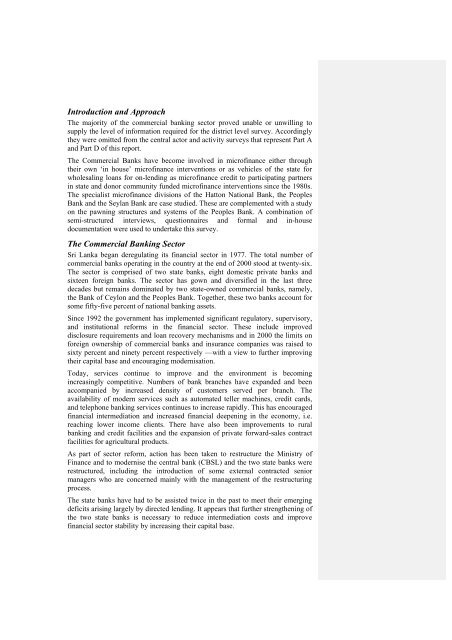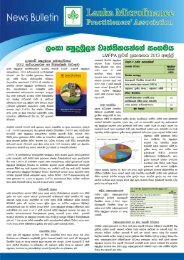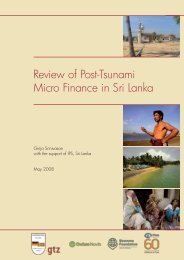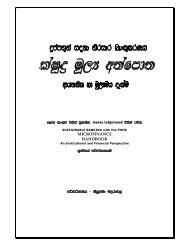National Microfinance Study of Sri Lanka: Survey of Practices and ...
National Microfinance Study of Sri Lanka: Survey of Practices and ...
National Microfinance Study of Sri Lanka: Survey of Practices and ...
Create successful ePaper yourself
Turn your PDF publications into a flip-book with our unique Google optimized e-Paper software.
Introduction <strong>and</strong> Approach<br />
The majority <strong>of</strong> the commercial banking sector proved unable or unwilling to<br />
supply the level <strong>of</strong> information required for the district level survey. Accordingly<br />
they were omitted from the central actor <strong>and</strong> activity surveys that represent Part A<br />
<strong>and</strong> Part D <strong>of</strong> this report.<br />
The Commercial Banks have become involved in micr<strong>of</strong>inance either through<br />
their own ‘in house’ micr<strong>of</strong>inance interventions or as vehicles <strong>of</strong> the state for<br />
wholesaling loans for on-lending as micr<strong>of</strong>inance credit to participating partners<br />
in state <strong>and</strong> donor community funded micr<strong>of</strong>inance interventions since the 1980s.<br />
The specialist micr<strong>of</strong>inance divisions <strong>of</strong> the Hatton <strong>National</strong> Bank, the Peoples<br />
Bank <strong>and</strong> the Seylan Bank are case studied. These are complemented with a study<br />
on the pawning structures <strong>and</strong> systems <strong>of</strong> the Peoples Bank. A combination <strong>of</strong><br />
semi-structured interviews, questionnaires <strong>and</strong> formal <strong>and</strong> in-house<br />
documentation were used to undertake this survey.<br />
The Commercial Banking Sector<br />
<strong>Sri</strong> <strong>Lanka</strong> began deregulating its financial sector in 1977. The total number <strong>of</strong><br />
commercial banks operating in the country at the end <strong>of</strong> 2000 stood at twenty-six.<br />
The sector is comprised <strong>of</strong> two state banks, eight domestic private banks <strong>and</strong><br />
sixteen foreign banks. The sector has gown <strong>and</strong> diversified in the last three<br />
decades but remains dominated by two state-owned commercial banks, namely,<br />
the Bank <strong>of</strong> Ceylon <strong>and</strong> the Peoples Bank. Together, these two banks account for<br />
some fifty-five percent <strong>of</strong> national banking assets.<br />
Since 1992 the government has implemented significant regulatory, supervisory,<br />
<strong>and</strong> institutional reforms in the financial sector. These include improved<br />
disclosure requirements <strong>and</strong> loan recovery mechanisms <strong>and</strong> in 2000 the limits on<br />
foreign ownership <strong>of</strong> commercial banks <strong>and</strong> insurance companies was raised to<br />
sixty percent <strong>and</strong> ninety percent respectively —with a view to further improving<br />
their capital base <strong>and</strong> encouraging modernisation.<br />
Today, services continue to improve <strong>and</strong> the environment is becoming<br />
increasingly competitive. Numbers <strong>of</strong> bank branches have exp<strong>and</strong>ed <strong>and</strong> been<br />
accompanied by increased density <strong>of</strong> customers served per branch. The<br />
availability <strong>of</strong> modern services such as automated teller machines, credit cards,<br />
<strong>and</strong> telephone banking services continues to increase rapidly. This has encouraged<br />
financial intermediation <strong>and</strong> increased financial deepening in the economy, i.e.<br />
reaching lower income clients. There have also been improvements to rural<br />
banking <strong>and</strong> credit facilities <strong>and</strong> the expansion <strong>of</strong> private forward-sales contract<br />
facilities for agricultural products.<br />
As part <strong>of</strong> sector reform, action has been taken to restructure the Ministry <strong>of</strong><br />
Finance <strong>and</strong> to modernise the central bank (CBSL) <strong>and</strong> the two state banks were<br />
restructured, including the introduction <strong>of</strong> some external contracted senior<br />
managers who are concerned mainly with the management <strong>of</strong> the restructuring<br />
process.<br />
The state banks have had to be assisted twice in the past to meet their emerging<br />
deficits arising largely by directed lending. It appears that further strengthening <strong>of</strong><br />
the two state banks is necessary to reduce intermediation costs <strong>and</strong> improve<br />
financial sector stability by increasing their capital base.
















